|
|
市場調査レポート
商品コード
1302933
ベアリングの世界市場-2023年から2028年までの予測Global Bearing Market - Forecasts from 2023 to 2028 |
||||||
カスタマイズ可能
|
|||||||
| ベアリングの世界市場-2023年から2028年までの予測 |
|
出版日: 2023年06月22日
発行: Knowledge Sourcing Intelligence
ページ情報: 英文 138 Pages
納期: 即日から翌営業日
|
- 全表示
- 概要
- 目次
ベアリング市場の2021年の市場規模は871億8,000万米ドルでした。
ベアリングは、機械の回転軸やその他の可動部を支える部品であり、摩擦を減らして滑らかな動きを促進し、機械の摩耗や損傷を最小限に抑え、効率的で信頼性の高い運転を可能にするように設計されています。ベアリングには、ボールベアリング、ローラーベアリング、プレーンベアリングなど、さまざまな種類と構成があり、スチール、セラミック、プラスチックなどの材料で作られています。ベアリングは、自動車、航空宇宙、産業、鉱業、建設などの用途で使用されています。産業機器や製造機器の使用の増加、自動車生産の増加、インフラ整備がベアリングの需要を押し上げます。
自動車生産の増加は、ベアリング市場の成長を後押しします。
可動部品間の摩擦は、自動車の部品の摩耗や破損を引き起こし、効率を低下させ、燃料消費量と排出量の増加につながります。ベアリングは、摩擦を減らし、全体的な効率を向上させるのに役立ちます。乗用車、トラック、バスなどの自動車用ベアリングは、トランスミッション、エンジン、ホイール、サスペンション、ステアリングなど様々な用途で使用されています。エンジンのベアリングは、クランクシャフト、カムシャフト、コネクティングロッドを支えるために使用され、トランスミッションでは、ギアやシャフトを支えるために使用され、摩擦を減らし、スムーズな変速を保証します。自動車の生産台数と使用台数の伸びは、ベアリングの需要を促進します。国際自動車工業会(OICA)によると、トラックやバスを含む商用車の生産台数は2021年から2022年にかけて1.41%増加しました。インド自動車工業会(SIAM)によると、乗用車の生産台数は2020~2021年の306万台から2021~2022年には365万台に増加しました。これは、ベアリングが将来的に大きな需要を持つことを示しています。
建設活動の急増がベアリングの需要を増大させています。
ベアリングは、可動部品間の摩擦を減らし、重荷重を支え、効率を向上させることで、建設業界で重要な役割を果たしています。建設業界は、掘削機、ローダー、クレーン、ブルドーザーに大きく依存しており、効率的に機能するためにはベアリングが必要です。建設活動の増加はベアリングの需要を押し上げます。設備製造業者協会(AEM)によると、世界の建設機械販売台数は2020年の16%減に続き、2021年は5%増となっています。欧州重機械工業会(CECE)によると、インフラと再生可能エネルギー・プロジェクトへの投資増加により、建設機械市場は2021年に9%成長しました。世界銀行によると、インフラ投資はCOVID後の経済回復の鍵を握っています。2020年、世界銀行はインド、エジプト、コロンビアなど様々な国の建設プロジェクトに180億米ドル以上の融資を承認しました。
2021年にはアジア太平洋地域が大きなシェアを占めました。
中国、日本、インドなどのアジア太平洋地域の経済成長は、自動車、建設、製造業で著しい成長を遂げており、ベアリングの需要も並行して伸びています。中国政府は、大型商用車の改良に向けた「大型商用車開発計画(2021~2035年)」を発表し、従来のディーゼル車の効率と安全性の向上に焦点を当てています。2021年、インド政府とドバイ政府は、ジャンムー・カシミール州に工業団地、情報技術タワー、多機能タワー、物流拠点、医科大学、専門病院などのインフラを建設する契約を締結しました。日本政府は2019年に「災害に強いインフラ整備」プログラムを開始し、地震や洪水などの自然災害に耐えるインフラへの投資を行う。自動車産業や建設・インフラ開発における排出ガス削減への関心の高まりは、その事業や開発においてベアリングを必要としています。これらの要因がアジア太平洋地域におけるベアリングの需要を高めています。
市場動向
- 2022年8月:AKFは、産業・製造セクターの高速用途向けに全く新しいハイブリッド深溝型ボールベアリングを製造。
- 2022年2月:ドイツのベアリングメーカー、シェフラーは、電気自動車用に特別設計された高効率ボールベアリング「TriFinity 3列ホイールベアリング」を発売。
- 2021年7月:ベアリングと関連製品の世界的メーカーであるティムケン社は、建設機械用の「ティムケン(R)クイックフレックス」ベアリングを発売しました。
目次
第1章 イントロダクション
- 市場概要
- 市場の定義
- 調査範囲
- 市場セグメンテーション
- 通貨
- 前提条件
- 基準年と予測年のタイムライン
第2章 調査手法
- 調査データ
- 調査プロセス
第3章 エグゼクティブサマリー
- 調査ハイライト
第4章 市場力学
- 市場促進要因
- 市場抑制要因
- 市場機会
- ポーターのファイブフォース分析
- 業界バリューチェーン分析
第5章 ベアリングの世界市場:タイプ別
- イントロダクション
- ボールベアリング
- ローラーベアリング
- プレーンベアリング
- その他
第6章 ベアリングの世界市場:素材別
- イントロダクション
- 鋼
- セラミック
- プラスチック
第7章 ベアリングの世界市場:エンドユーザー別
- イントロダクション
- 自動車
- 航空宇宙
- 産業用
- 鉱業
- 建設
- その他
第8章 ベアリングの世界市場:地域別
- イントロダクション
- 北米
- 米国
- カナダ
- メキシコ
- 南米
- ブラジル
- アルゼンチン
- その他
- 欧州
- ドイツ
- 英国
- フランス
- スペイン
- その他
- 中東・アフリカ
- サウジアラビア
- アラブ首長国連邦
- その他
- アジア太平洋
- 中国
- 日本
- 韓国
- インド
- オーストラリア
- その他
第9章 競合環境と分析
- 主要企業と戦略分析
- 新興企業と市場収益性
- 合併、買収、合意およびコラボレーション
- ベンダー競争力マトリックス
第10章 企業プロファイル
- IKO International
- JTEKT Corporation
- NACHI-FUJIKOSHI CORP
- NSK Ltd.
- NTN Corporation
- RBC Bearing Incorporated
- Schaeffler Group
- Scheerer Bearing Corporation
- SKF
- Timken Company
The global bearing market was valued at US$87.18 billion in 2021.
A bearing is a component that supports a rotating shaft or other moving parts in machinery and is designed to reduce friction and facilitate smooth movement, minimize wear and tear on the machinery, and enable efficient and reliable operation. Bearings come in different types and configurations, such as ball bearings, roller bearings, and plain bearings, and are made of materials like steel, ceramic, or plastic. Bearing is used in automotive, aerospace, industrial, mining, and construction applications. The increasing use of industrial and manufacturing equipment, growing automobile production, and infrastructure development will boost the demand for bearings.
The increasing automotive production will boost the growth of the global bearing market.
Friction between moving parts can cause wear and tear on the components of an automobile and reduce its efficiency, leading to increased fuel consumption and emissions, and bearings can help to reduce friction and improve overall efficiency. Automobile bearings like passenger cars, trucks, and buses are used in various applications like transmission, engine, wheels and suspension, and steering. Bearings in the engine are used to support the crankshaft, camshaft, and connecting rods, and in transmission, it is used to support the gears and shafts, reducing friction and ensuring smooth shifting. The positive growth of vehicle production and usage will fuel the demand for bearings. According to the International Organization of Motor Vehicle Manufacturers (OICA), the production of commercial vehicles, including trucks and buses, increased by 1.41% from 2021 to 2022. According to the Society of Indian Automobile Manufacturers (SIAM), the production of passenger vehicles increased from 3.06 million in 2020-2021 to 3.65 million in 2021-2022. This demonstrates that bearings hold a great demand in the future.
The surge in construction activities is augmenting the demand for bearings.
Bearings play a critical role in the construction industry by reducing friction between moving parts, supporting heavy loads, and improving efficiency. The construction industry relies heavily on excavators, loaders, cranes, and bulldozers, all requiring bearings to function efficiently. The growth in construction activities boosts the demand for bearings. According to the Association of Equipment Manufacturers (AEM), global construction equipment sales increased by 5% in 2021, following a decline of 16% in 2020. According to the European Association of Heavy Machinery Manufacturers (CECE), the construction equipment market grew by 9% in 2021 due to increased investment in infrastructure and renewable energy projects. According to the World Bank, infrastructure investments are key to the post-COVID economic recovery. In 2020, the World Bank approved over $18 billion in financing for construction projects in various countries, including India, Egypt, and Colombia.
The Asia Pacific region held a significant share in 2021.
The growing economies in the Asia Pacific region, such as China, Japan, and India, are witnessing significant growth in the automotive, construction, and manufacturing industries, parallelly driving the demand for bearings. The Chinese government released a "Development Plan for Heavy-duty Commercial Vehicles (2021-2035)" for the improvement of heavy-duty commercial vehicles, which focuses on improving the efficiency and safety of traditional diesel vehicles. In 2021, the governments of India and Dubai signed a contract to build infrastructure in Jammu and Kashmir, including industrial parks, information technology towers, multifunctional towers, logistical hubs, medical colleges, and specialized hospitals. The Japanese government launched the " Disaster Resilient Infrastructure Development" program in 2019, which includes investments in infrastructure that can withstand earthquakes, floods, and other natural disasters. The increasing concern to reduce emissions in the automotive industry and construction and infrastructure developments need bearings in their operations and developments. These factors all increase the demand for bearings in the Asia Pacific region.
Market Developments:
- August 2022: AKF produced a brand-new hybrid deep groove ball bearing for high-speed applications in the industrial and manufacturing sector.
- February 2022: Schaeffler, a German bearing manufacturer, launched a high-efficiency ball bearing called "TriFinity triple-row wheel bearing, " specially designed for electric vehicles.
- July 2021: Timken, a global manufacturer of bearings and related products, launched the "Timken®Quick-Flex" bearing for construction equipment which offers high torque capacity and easy installation, making them ideal for use in a range of construction applications.
Market Segmentation:
By Type
- Ball Bearing
- Roller Bearing
- Plain Bearing
- Others
By Material
- Steel
- Ceramic
- Plastic
By End-User
- Automotive
- Aerospace
- Industrial
- Mining
- Construction
- Others
By Geography
- North America
- USA
- Canada
- Mexico
- South America
- Brazil
- Argentina
- Others
- Europe
- UK
- Germany
- France
- Spain
- Others
- Middle East and Africa
- Saudi Arabia
- UAE
- Others
- Asia Pacific
- China
- Japan
- India
- South Korea
- Australia
- Other
TABLE OF CONTENTS
1. INTRODUCTION
- 1.1. Market Overview
- 1.2. Market Definition
- 1.3. Scope of the Study
- 1.4. Market Segmentation
- 1.5. Currency
- 1.6. Assumptions
- 1.7. Base, and Forecast Years Timeline
2. RESEARCH METHODOLOGY
- 2.1. Research Data
- 2.2. Research Process
3. EXECUTIVE SUMMARY
- 3.1. Research Highlights
4. MARKET DYNAMICS
- 4.1. Market Drivers
- 4.2. Market Restraints
- 4.3. Market Opportunities
- 4.4. Porter's Five Force Analysis
- 4.4.1. Bargaining Power of Suppliers
- 4.4.2. Bargaining Power of Buyers
- 4.4.3. Threat of New Entrants
- 4.4.4. Threat of Substitutes
- 4.4.5. Competitive Rivalry in the Industry
- 4.5. Industry Value Chain Analysis
5. GLOBAL BEARING MARKET, BY TYPE
- 5.1. Introduction
- 5.2. Ball Bearing
- 5.3. Roller Bearing
- 5.4. Plain Bearing
- 5.5. Others
6. GLOBAL BEARING MARKET, BY MATERIAL
- 6.1. Introduction
- 6.2. Steel
- 6.3. Ceramic
- 6.4. Plastic
7. GLOBAL BEARING MARKET, BY END-USER
- 7.1. Introduction
- 7.2. Automotive
- 7.3. Aerospace
- 7.4. Industrial
- 7.5. Mining
- 7.6. Construction
- 7.7. Others
8. GLOBAL BEARING MARKET, BY GEOGRAPHY
- 8.1. Introduction
- 8.2. North America
- 8.2.1. USA
- 8.2.2. Canada
- 8.2.3. Mexico
- 8.3. South America
- 8.3.1. Brazil
- 8.3.2. Argentina
- 8.3.3. Others
- 8.4. Europe
- 8.4.1. Germany
- 8.4.2. UK
- 8.4.3. France
- 8.4.4. Spain
- 8.4.5. Others
- 8.5. Middle East and Africa
- 8.5.1. Saudi Arabia
- 8.5.2. UAE
- 8.5.3. Others
- 8.6. Asia Pacific
- 8.6.1. China
- 8.6.2. Japan
- 8.6.3. South Korea
- 8.6.4. India
- 8.6.5. Australia
- 8.6.6. Others
9. COMPETITIVE ENVIRONMENT AND ANALYSIS
- 9.1. Major Players and Strategy Analysis
- 9.2. Emerging Players and Market Lucrativeness
- 9.3. Mergers, Acquisitions, Agreements, and Collaborations
- 9.4. Vendor Competitiveness Matrix
10. COMPANY PROFILES
- 10.1. IKO International
- 10.2. JTEKT Corporation
- 10.3. NACHI-FUJIKOSHI CORP
- 10.4. NSK Ltd.
- 10.5. NTN Corporation
- 10.6. RBC Bearing Incorporated
- 10.7. Schaeffler Group
- 10.8. Scheerer Bearing Corporation
- 10.9. SKF
- 10.10. Timken Company





